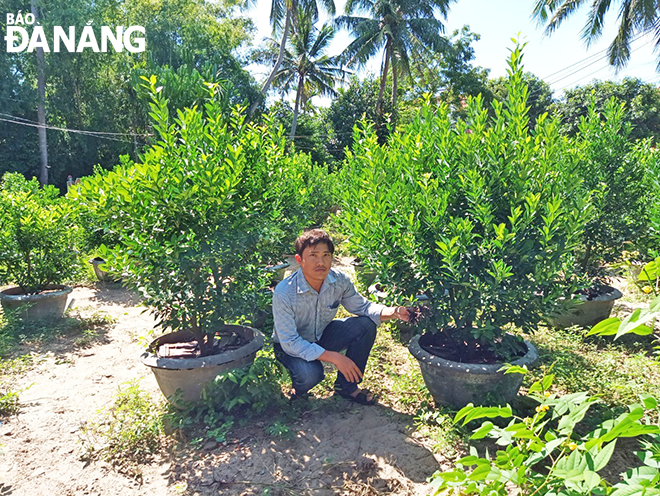Da Nang lecturer produces bio-organic fertilizer from poultry feathers
Dr. Ta Ngoc Ly, who is a lecturer in Biotechnology Major of the Da Nang University of Science and Technology - the University of Da Nang, has successfully made a type of bio-organic fertilizer from chicken feathers with the desire to reduce environmental pollution from by-products such as chicken feathers.
Composted in a closed system, this type of fertilizers has no harmful microorganisms and boasts good quality, simple process and low production cost.
 |
| Dr. Ta Ngoc Ly in the kumquat garden fertilized with bio-organic fertilizer from poultry feathers. Photo: H.T.V |
Solving problems from chicken feathers
Teaching in the field of biotechnology, Dr. Ly is always concerned about finding out how to apply technology to turn chicken feathers into useful products.
“The volume of chicken feathers at the poultry production and processing facilities can reach tens of tons per month, but just discarding waste chicken feathers are neither cost-effective nor eco-friendly. This inspires me to research the formula to produce fertilizer from chicken feathers so as to help farmers and protect the living environment from pollution”, said Dr. Ly.
Chicken feathers are rich in protein content, so they can be used as animal feed and fertilizer for plants. Farmers often use chicken feathers as fertilizer, but their steps of conventional composting lose nutrients, and cause bad odors and pollution for a long time. Keratin from chicken feathers, which is a protein with a fibrous structure, is insoluble in water, and is difficult to decompose by common agents. Therefore, Dr. Ly proposed a method of composting in the direction of reducing costs, improving fertilizer quality, and being safe for the environment.
“We need effective microbial strain that helps decompose keratin in chicken feathers quickly. Chicken feathers contain protein, so it is not possible to use only chicken feathers to incubate, if so, the created fertilizer has an unbalanced nutritional composition. Therefore, how to create the most suitable environment for microorganisms to grow, thereby helping to shorten time and save costs, is one of the most concerned issues that is needed to be resolved before embarking on the composting process” said Dr. Ly said.
The process of making fertilizer from chicken feathers
To optimize the composting process, Dr. Ly has to use additional substrates with the proportion of chicken feather being 50%, rice bran 20%, rice husk ash 5%, and coconut humus 25% to create mixed fermentation with two parameters: addition of lime and moisture. The humidity is neither too dry nor too wet by adding water, whilst lime will help adjust the pH of the compost and kill a part of harmful microorganisms in the chicken feathers.
Next, Dr. Ly uses a mixture of activated microorganisms in the production of fertilizer from poultry feathers and controlled composting technology.
A tank is designed to be stirred for ventilation, without creating odors, and is combined with a rotating drum with a sieve mesh. The drum is fixed in a frame and has a mesh underneath, creating a layer that contain enzymes capable of breaking down poultry feathers very strongly for culturing Streptomyces, Bacillus, and Lactobacillus microorganisms.
By putting this microbial mixture into incubation, it only takes a short time to decompose chicken feathers, thereby limiting odour and production of the Plant Growth Stimulant Indol Acetic Acid (IAA).
After 5 days of incubation, mold thrives, and the temperature of the compost block is very high. In the next two weeks, the feathers decompose, excluding tubular hairs. A month later, most of the feathers fully decompose. The basic composting process is complete. The part that passes through the sieve to the bottom is decomposed and can be used, whilst the other parts that are on the grid are left in the bin to continue fermentation process. As a result, bio-organic fertilizer is made, which is a darker, smoother, and wetter than conventional ones.
Dr. Ly pointed out the great potential of the production of bio-organic fertilizer from chicken feathers as there is currently no research on bio-fertilizer production from chicken feather waste, and chicken feathers as well.
Reporting by HUYNH TUONG VY – Translating by M.DUNG